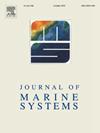Fine-scale phytoplankton community transitions in the oligotrophic ocean: A Mediterranean Sea case study
IF 2.5
3区 地球科学
Q2 GEOSCIENCES, MULTIDISCIPLINARY
引用次数: 0
Abstract
The vast diversity of marine phytoplankton, shaped by intricate water dynamics, remains poorly understood in the oligotrophic ocean. In situ studies reveal fine-scale dynamics affecting phytoplankton distribution, leading to abrupt shifts in abundance and biomass referred here as “phytoplankton community transitions” (PCTs). Using a simple nutrient–phytoplankton–zooplankton (NPZ) numerical model, our study proposes a theoretical framework to explain PCTs observed during an oceanographic cruise in the Mediterranean Sea. We consider both a homogeneous and a variable environment, respectively corresponding to the waters on both sides of a front and to the frontal area itself. In the model, PCTs between one community of smaller phytoplankton and one community of bigger phytoplankton are controlled by nutrient supply, but not directly: nutrient supply affects all compartments of the model and creates PCTs by combining bottom-up and top-down controls. This mechanism is observed for both constant (i.e., within a water mass) and pulsed (i.e., in the front) nutrient supply. These results are consistent with in situ observations of biomass proportion across a front. This theoretical framework helps to better understand and plan in situ observations in oceanic regions characterized by fine-scale dynamics and oligotrophic conditions.
寡营养海洋中细尺度浮游植物群落过渡:地中海案例研究
海洋浮游植物种类繁多,由错综复杂的水动力学决定,但人们对寡营养海洋中的浮游植物仍然知之甚少。原位研究揭示了影响浮游植物分布的细尺度动态,导致丰度和生物量的突然变化,在这里被称为 "浮游植物群落过渡"(PCTs)。我们的研究利用一个简单的营养-浮游植物-浮游动物(NPZ)数值模型,提出了一个理论框架来解释在地中海海洋巡航期间观测到的 PCT。我们考虑了同质环境和可变环境,分别对应于锋面两侧水域和锋面区域本身。在模型中,一个较小浮游植物群落和一个较大浮游植物群落之间的 PCT 受养分供应的控制,但不是直接控制:养分供应影响模型的所有区块,并通过自下而上和自上而下的控制相结合产生 PCT。这种机制在恒定(即在一个水团内)和脉冲(即在前沿)营养供应情况下均可观察到。这些结果与前沿生物量比例的现场观测结果一致。这一理论框架有助于更好地理解和规划以精细尺度动力学和寡营养条件为特征的海洋区域的现场观测。
本文章由计算机程序翻译,如有差异,请以英文原文为准。
求助全文
约1分钟内获得全文
求助全文
来源期刊

Journal of Marine Systems
地学-地球科学综合
CiteScore
6.20
自引率
3.60%
发文量
81
审稿时长
6 months
期刊介绍:
The Journal of Marine Systems provides a medium for interdisciplinary exchange between physical, chemical and biological oceanographers and marine geologists. The journal welcomes original research papers and review articles. Preference will be given to interdisciplinary approaches to marine systems.
 求助内容:
求助内容: 应助结果提醒方式:
应助结果提醒方式:


